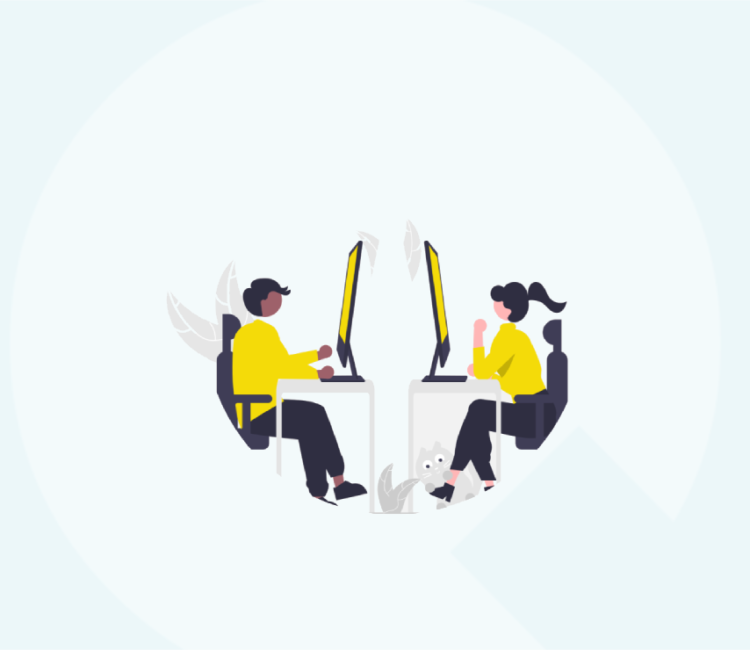Due to the current COVID-19 pandemic working from home has become a necessity rather than an option. Where once it was the preserve of the freelancer or people with flexible working schemes it is now how we all have to work.
For some this is an easy transition, for others it is complex, stressful and full of challenges. We wanted to look through some of the main factors that go to make working from home as healthy and sustainable as possible…after all, we may be doing it for a while.
Physical Comfort
First and foremost, you need to think about your physical set up. Company offices are often designed to consider the health and comfort of employees, they have natural light, the desks are the right height and many other factors are in place to make sure we are all productive and comfortable.
At home it’s all too easy to pull up a chair to your laptop and get cracking and finish the day with a sore back or a crook in your neck or shoulders. Over time these ailments will get worse and can compound other issues like stress and challenges of remote working.
It’s important to ensure you have a good seated position, but it’s more than just how you sit, it’s how your arms rest when typing, it’s what angle your head is at to read your screen and more. Jasi Bansel, an Osteopath and home working expert in Haywards Heath offers some practical advice on what this involves. You need to consider:
The chair – can you alter the height and angle, so it is appropriate for your screen and desk height? It is really important you can, however you may not have access to an adjustable chair at home. Cushions can help as well as using books to stand your laptop on to alter the height.
Your body – you should sit on the 2 bones in your bottom, and your feet should be parallel on the floor in-front of you, your shoulders back and down. It is important to actively think about this throughout the day. Stop work for 30 seconds and consider your position, it will become habit over time.
Screen – the top of your screen should be about eye level. Once again, most of us are unlikely to have fine adjustment on our “home set ups” so improvise if you can.

Type of computer
If you have a desktop computer, it is much easier to ensure that your position is optimal. This extends to the keyboard and mouse, which, if used correctly can also make a difference to your comfort and to avoiding issues in the hands, wrists and shoulders.
If you only have a laptop but use it for long periods you should buy a stable stand to ensure the screen is elevated to the right height along with a separate keyboard and mouse to use when at home. You could also buy a monitor to use alongside the laptop which is much cheaper than a PC.
The NHS has guidance on laptop use. It is also important to set up your monitor properly. Whether it’s a laptop of PC screen make sure the brightness is enough to see easily but not so much it causes glare. You may not know it initially, but you will find your eyes are more tired than normal if your screen is too bright or too dark.
Make the most of your work space
Having no separation between work and home can exacerbate cabin fever and it is fair to say everyone is feeling a little like that right now. Try and set up a dedicated workspace at home that will allow you to sit comfortably with the correct computer set up.
One of the big challenges in times like these where people are forced to work from home is, they may not have a suitable space. This can become a problem in terms of morale, seating position and more.
If you are unnecessarily crammed in a corner try to find some space, or make sure you get to move around more often. Tidy up and make a bit more space around you if at all possible. The usual desk clutter we all have can become a real problem when working in a smaller space at home. If you can be near a window this is great but for many this may not be suitable.
Put up a calendar and pin board or anything that will make it feel like your office and have the right storage for your files and equipment. The more it is separate from the house and its chores or distractions, the better for your focus. These are all “nice to haves” and we may not be able to do them all but every small change helps.
Breaks
At an office the day is often punctuated by comings and goings of colleagues, but at home can be one of two ways and neither is ideal. Working from home can be solitary and very intense but if children are involved then it can be full of distractions and very stressful. You need to remember to take regular breaks regardless of the situation.
The recommended advice is to take a break every half an hour, but you should ensure you do so every hour at least. You can set reminders on your phone or computer if necessary. A break shouldn’t just be taking your mind off the work and switching to social media, you should get up and away from your screens and move around; stretching exercises are ideal.
Also try to get outside at least once a day. Go for a walk at lunchtime if you can. It’s all too easy to think “I’ll just keep at it”, but you will often find that a proper break and some air will help you return to work fresh and efficient. Working from home can be very productive, what may have taken all day in the office can take just a few hours at home.
This can them lead us to carry on and take on another task instead of taking a break. Having noisy kids around can do the opposite and make a simple two hour job take all day. The key here is to be aware of the situation and give yourself breaks around your lifestyle.

Image: Pexels
Routine and structure
At first it can seem great that you get to manage your own time, but this is often more challenging than you imagine. Finding the motivation to work with no one around can be a battle. Setting yourself some routine or structure can be really helpful.
Have a work start time because if you allow yourself to drift into work this can quickly slip. Indeed, getting started for the day is often the tricky bit. It’s a good idea to write a ‘to do’ list at the end of the day before and then start the morning with this and a sense of what you want to achieve before lunch and by the end of the day.
Recognise when you are at your most productive and plan your tasks around this. Plan a finish time too and try to stick to it. The distractions when working from home can be more intense than those commonly found in the office for some people so it is important to know them and minimise as much as possible.
Community and human interaction
It can be great to have the freedom of working at home, but it can be isolating and easier to get stuck on some issue without anyone to share ideas with. Wherever possible try to be part of a remote community. If you have other colleagues or staff then try a communication app like Slack or Zoom which is hugely popular at the moment.
Effectively communicating with staff or people you work with is vitally important on a number of levels. Or perhaps you have friends in a similar situation, or people who might be able to assist you with certain aspects of your work.
Obviously, we cannot simply pop to the shop or a coffee at the moment so use online tools to remain social but don’t forget a good old fashioned phone call can help a lot too. Talking to your kids, if you have them, doesn’t really count so remember to make sure you get some adult conversation.
Summary
Working from home is no longer a choice it is a requirement and making sure we stay healthy and productive is vital. There are a number of areas where we can improve our home working processes to avoid aches and pains, stress, distractions and more. By staying healthy and productive we can play an important role in not only keeping companies going but the wider economy too.
About the Author
Aaron James is a freelance writer from Sussex working in a range of business verticals from eCommerce to Staffing and HR. As well as business writing Aaron also works on content in other areas including mental health, science and marketing. When he isn’t writing Aaron spends his time trying to find a good waves to ride in the South of England…which isn’t very easy!



